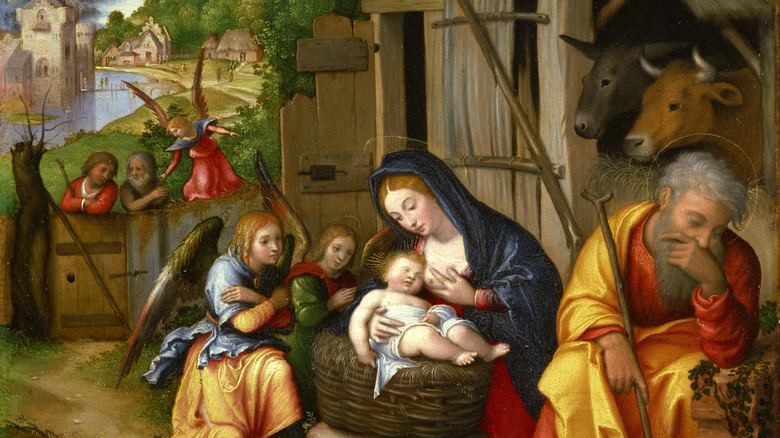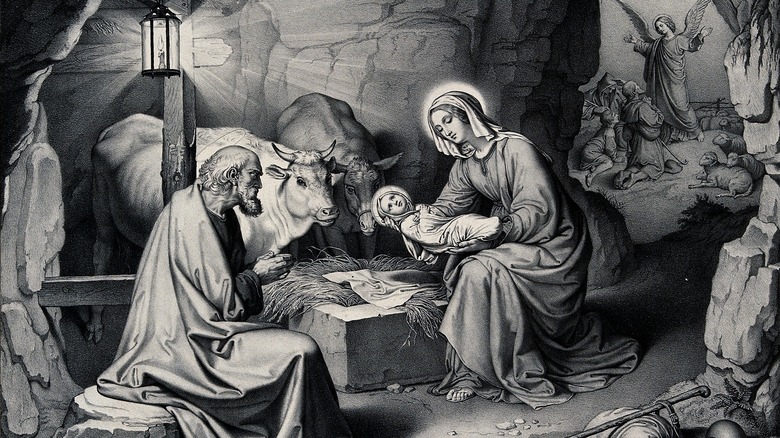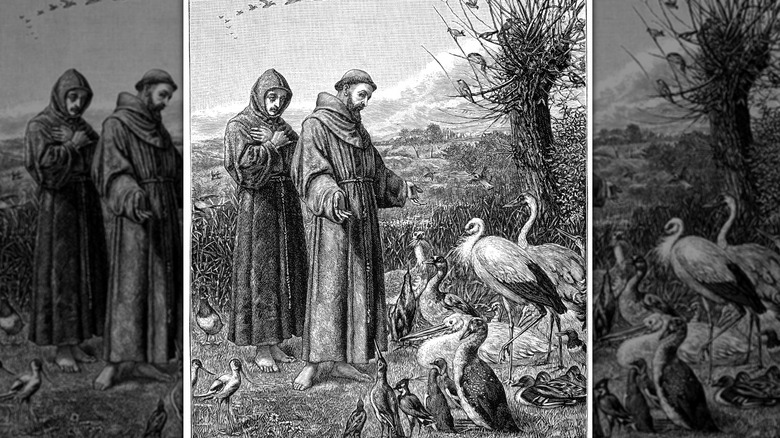Why Animals Are In The Nativity Scene, But Aren't Mentioned In The Bible
Nestled within the Christmas decorations of households the world over is a depiction of the Nativity. Ornaments, figurines, cards, and homemade crafts all carry on a tradition that dates back to the beginnings of Christianity. Per Britannica, the earliest depictions of the Nativity come from the 4th century, but the details have evolved considerably over the millennia. In fact, the modern, popular conception of the scene doesn't entirely square with the gospels.
Of course, the gospels themselves don't entirely square with one another concerning the birth of Jesus. Two of them neglect to mention his birth at all, including Mark — likely the oldest of them, according to National Geographic. The story behind the Nativity is found in Matthew and Luke, though neither book contains all the popular elements. Matthew has the three wise men, the star, and the threat from King Herod; Luke has the manger and the shepherds. Prevailing aesthetic and theological trends determined which of these aspects of the Nativity was included in the artwork, and some elements were occasionally outlawed by the church for violating doctrine.
Among the Nativity features that faced prohibition at one time or another was an element that dates back to the earliest depictions and isn't mentioned in any of the gospels: animals, typically an ox and a donkey. In his book "Jesus of Nazareth: The Infancy Narratives," Pope Benedict XVI attributed their presence to mentions of both animals elsewhere in the Bible (via The Guardian). He was considerably more friendly than some of his predecessors, vowing that the animals in the Vatican's Nativity display were there to stay.
Gnostic texts include animals in the birth of Jesus
Pope Benedict XVI may have credited other parts of the Bible with influencing artists who included animals in the Nativity, but there was Christian writing that put a donkey and an ox on the scene of Jesus' birth. The Book of Pseudeo-Matthew incorporates elements from the gospels of Matthew and Luke, though events are rearranged (via The Gnostic Society Library). As per Luke, Joseph and Mary traveled to Bethlehem after Caesar Augustus for a census, and an angel told the shepherds of the newborn Christ. Per Matthew, three wise men came to pay young Jesus homage, albeit several days after his birth, and King Herod sought the child's death. But Pseudo-Matthew includes the donkey Mary rode on the way to Bethlehem and even has an angel command the animal to rise and deliver Mary unto the shelter of a cave. (Per Britannica, stables in caves were customary in Palestine, and early Nativity depictions were often set there).
In Pseudo-Matthew, Mary's donkey and the oxen living in a stable loved Jesus on sight after visiting him. So too did animals rarely connected to the Nativity or Christmas. While hiding in another cave from Herod, Jesus and his family encountered dragons, which the young Jesus quickly tamed. When his family set out into the desert again, they were accompanied by panthers and lions, who loved Christ just as the ox and donkey had. They even managed to safely pass through packs of wolves.
[Featured image by Wellcome Images via Wikimedia Commons | Cropped and scaled | CC BY 4.0 DEED]
Animals in the Nativity were popularized by Saint Francis
Writing for The Conversation, Professor Vanessa Corcoran dates the Book of Pseudo-Matthew (also known as the Infancy Gospel of Matthew) to the 7th century. She credits the book as the first to include animals in the Nativity. But she links the popular image — an ox and donkey alongside shepherds, three wise men, and Joseph and Mary welcoming Jesus into the world in a manger — to the live Nativity scenes popularized by Saint Francis of Assisi in the 13th century.
According to the National Catholic Register, Francis visited Israel between 1219 and 1220, and it was likely this visit that inspired him to stage a live depiction of the Nativity in 1223. With permission from Pope Honorious III, he arranged for the scene to be staged in a cave outside of Greccio, Italy that Christmas. The ox and the donkey were real, but Jesus (per Corcoran) was represented by a doll. At least one witness reported a vision of the doll as the real Christ child in Francis's arms, crying real tears, and the hay used in the scene was later reported to provide cures to animals and people alike.
Three-dimensional representations of the Nativity, also known as crèches, likely predated Francis's display (per Britannica), but the University of Dayton credits Francis with putting on the first live drama. Pope Francis has written about his namesake's effort and visited the cave where the Nativity was performed twice.


